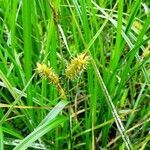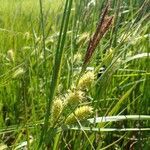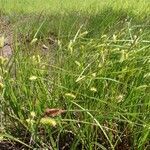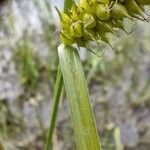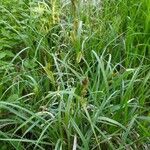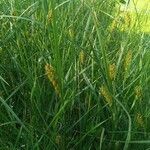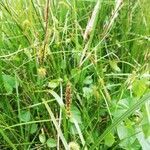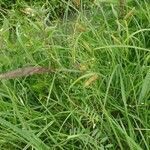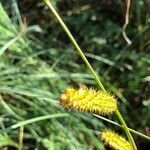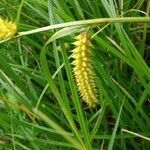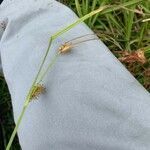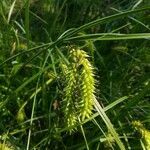Rhizome stoloniferous, stolons branched. Culms 30-100 cm tall, ± stiff, triquetrous, scabrous on upper part, with red-brown and bladeless sheaths at base, rudimentary sheaths usually disintegrating into reticulate fibers. Leaves slightly shorter than culm, blades 2-5 mm wide, flat, ± stiff, with transverse septate nodes between veins, sheathed. Involucral bracts leaflike, lowermost shortly sheathed, upper not sheathed. Spikes 4-6, remote; terminal 2 or 3 spikes male, approximate, linear-cylindric, 2-3.5 mm, subsessile; remaining spikes female, oblong or oblong-cylindric, 3-7 × 1-1.5 cm, densely many flowered, shortly pedunculate. Female glumes pale ferruginous or ferruginous, narrowly ovate or ovate-lanceolate, ca. 3.2 mm, membranous, 3-veined, yellow-green between veins, margins white hyaline, apex acuminate and muticous. Utricles yellowish green, obliquely patent, longer than glume, ovate or conic-ovate, inflated trigonous, 6-8 mm, subleathery, slightly nitid, glabrous, several veined, base rounded, shortly stipitate, apex attenuate into a short beak, orifice 2-toothed. Nutlets rather loosely enveloped, obovate, trigonous, 1.7-2 mm, base stipitate; style slender, usually flexuose, base not thickened; stigmas 3, rather short. Fl. and fr. May-Jul.
Plants cespitose; rhizomes short. Culms trigonous in cross section, 15–105 cm, scabrous-angled distally. Leaves: basal sheaths reddish brown to reddish purple, thickened, not spongy; ligules longer than wide; blades mid to dark green, V-to W-shaped, widest leaves 1.8–6.5 mm wide, smooth. Inflorescences 7.5–45 cm; proximal bract 10–50 cm, exceeding but not more than 2.5 times longer than inflorescence; proximal 1–3 spikes pistillate, erect or the proximal ascending, ca. 20–150-flowered, cylindric; terminal 1–3 spikes staminate, well elevated beyond summit of separate pistillate spikes. Pistillate scales lanceolate to narrowly ovate, 2.4–5.8 × 1.2–1.7 mm, shorter than perigynia, margins entire, apex acute to acuminate, awnless. Perigynia ascending, often green or straw colored, 7–12-veined, veins running into beak, ovate, (3.6–) 4–7.5(–8.2) × 1.7–3.5(–4.5) mm, 2–3.5 times as long as wide, papery, apex contracted; beak distinct, 1.1–2.6 mm, bidentulate, smooth, teeth straight, 0.3–0.9 mm. Stigmas 3. Achenes yellow to pale brown, symmetric, not indented, trigonous, smooth. 2n = 70, 74, 82, 88.
